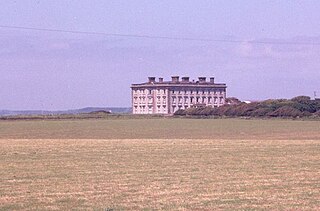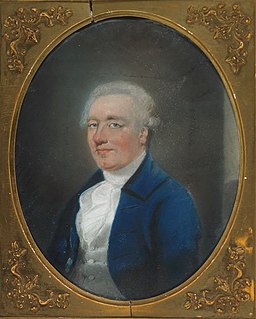
Duke of Devonshire is a title in the Peerage of England held by members of the Cavendish family. This branch of the Cavendish family has been one of the wealthiest British aristocratic families since the 16th century and has been rivalled in political influence perhaps only by the Marquesses of Salisbury and the Earls of Derby.

Robert Stewart, 1st Marquess of LondonderryPC (Ire) (1739–1821), was a County Down landowner, Irish Volunteer, and member of the parliament who, exceptionally for an Ulster Scot and Presbyterian, rose within the ranks of Ireland's "Anglican Ascendancy." His success was fuelled by wealth acquired through judicious marriages, and by the advancing political career of his son, Viscount Castlereagh. In 1798 he gained notoriety for refusing to intercede on behalf of James Porter, his local Presbyterian minister, executed outside the Stewart demesne as a rebel.

Marquess of Lansdowne is a title in the Peerage of Great Britain created in 1784, and held by the head of the Petty-Fitzmaurice family. The first Marquess served as Prime Minister of Great Britain.

Marquess of Ely, of the County of Wexford, is a title in the Peerage of Ireland. It was created in 1800 for Charles Loftus, 1st Earl of Ely. He was born Charles Tottenham, the son of Sir John Tottenham, 1st Baronet, who had been created a baronet, of Tottenham Green in the County of Wexford, in the Baronetage of Ireland in 1780, by Elizabeth, daughter of Nicholas Loftus, 1st Viscount Loftus, sister and heiress of Henry Loftus, 1st Earl of Ely. In 1783 he succeeded to the Loftus estates on the death of his maternal uncle the Earl of Ely and assumed the same year by Royal licence the surname of Loftus in lieu of his patronymic. In 1785 he was raised to the Peerage of Ireland as Baron Loftus, of Loftus Hall in the County of Wexford. It was sold by the family in 1917 and is today owned by the Quigley family.

Marquess of Londonderry, of the County of Londonderry, is a title in the Peerage of Ireland.

Marquess Conyngham, of the County of Donegal, is a title in the Peerage of Ireland. It was created in 1816 for Henry Conyngham, 1st Earl Conyngham. He was the great-nephew of another Henry Conyngham, 1st Earl Conyngham, a member of a family of Scottish descent which had settled during the Plantation of Ulster in County Donegal in Ireland in the early 17th century. The 'founder' of the dynasty in Ireland was The Very Rev. Dr. Alexander Cunningham, Dean of Raphoe. The earlier Henry was a member of both the Irish House of Commons and the British House of Commons and served as Vice-Admiral of Ulster and as Governor of the counties of Donegal and Londonderry. In 1753 he was raised to the Peerage of Ireland as Baron Conyngham, of Mount Charles in the County of Donegal, and in 1756 he was created Viscount Conyngham, in Ireland, also in the Peerage of Ireland. In 1781 he was made Baron Conyngham, of Mount Charles in the County of Donegal, with remainder to his nephew Francis Burton, and Earl Conyngham, of Mount Charles in the County of Donegal, which like the creations of 1753 and 1756 was created with normal remainder to the heirs male of his body. The latter titles were also in the Peerage of Ireland. Lord Conyngham was childless and on his death in 1781 the barony of 1753, the viscountcy and earldom became extinct while he was succeeded in the barony of 1781 according to the special remainder by his aforementioned nephew Francis. He was the eldest son of Mary, sister of the first Earl Conyngham, by her husband Francis Burton. The new 2nd Baron Conyngham, who had earlier represented Killybegs and County Clare in the Irish House of Commons, assumed by Royal licence the surname and arms of Conyngham on succeeding to the titles.

Marquess of Ailesbury, in the County of Buckingham, is a title in the Peerage of the United Kingdom. It was created on 17 July 1821 for Charles Brudenell-Bruce, 2nd Earl of Ailesbury.

Earl of Cardigan is a title in the Peerage of England, currently held by the Marquesses of Ailesbury, and used as a courtesy title by the heir apparent to that Marquessate, currently David Brudenell-Bruce, Earl of Cardigan, son of the 8th Marquess. The Brudenell family descends from Sir Robert Brudenell, Chief Justice of the Common Pleas from 1520 to 1530. His great-grandson, Sir Thomas Brudenell, was created a Baronet in the Baronetage of England, styled "of Deene in the County of Northampton", on 29 June 1611. On 26 February 1628, he was raised to the Peerage of England as Baron Brudenell, of Stanton Wyvill in the County of Leicester, and on 20 April 1661 he was further honoured when he was made Earl of Cardigan, also in the Peerage of England. On his death, the titles passed to his son, Robert, the 2nd Earl, and on the 2nd Earl's death to his grandson, George, the 3rd Earl, the 2nd Earl's only son, Francis, Lord Brudenell, having predeceased his father.

Earl of Ely is a title that has been created three times in the Peerage of Ireland for members of the Loftus family. This family descended from Nicholas Loftus, 1st Viscount Loftus, who was raised to the Peerage of Ireland as Baron Loftus, of Loftus Hall in the County of Wexford, in 1751. In 1756 he was further honoured when he was made Viscount Loftus, of Ely in the County of Wicklow. He was succeeded by his son, Nicholas, the second Viscount. He had previously represented Fethard in the Irish House of Commons. In 1766 he was created Earl of Ely in the Peerage of Ireland. Lord Ely assumed the additional surname of Hume. He was succeeded by his son, Nicholas, the second Earl. He represented both Fethard and Bannow in the Irish Parliament.

Baron Dufferin and Claneboye, of Ballyleidy and Killyleagh in County Down, Northern Ireland, is a title in the Peerage of Ireland. It was created 30 July 1800 for Dame Dorcas Blackwood, widow of Sir John Blackwood, 2nd Baronet, Member of the Irish Parliament for Killyleagh and Bangor, in return for support for the Union of Ireland and the United Kingdom.

Scroop Egerton, 1st Duke of Bridgewater, known as Viscount Brackley from 1687 to 1701 and as the 4th Earl of Bridgewater from 1701 to 1720, was a British peer, courtier and pioneering landowner.
Viscount Loftus is a title that has been created three times in the Peerage of Ireland for members of the Anglo-Irish Loftus family. The first creation was for Adam Loftus on 10 May 1622, who served as Lord Chancellor of Ireland in 1619. This title became extinct in 1725 upon the death of the third viscount. The second creation was for Nicholas Loftus in 1756, a great-grandson of Adam and a member of the Irish House of Commons. Two of his sons were created earls as Earl of Ely, although both titles became extinct. The third creation of the title was for Charles Loftus in 1789, who became Marquess of Ely in 1800. This title is extant.
John Butler, 17th Earl of Ormonde, 10th Earl of Ossory (1740–1795) was an Irish peer and Member of Parliament (MP). He represented Gowran between 1776 and 1783, and Kilkenny City between 1783 and 1792. In 1791, his right to the peerage was acknowledged in the Irish House of Lords.
George Henry Wellington Loftus, 7th Marquess of Ely, styled Viscount Loftus between 1925 and 1935, was an Irish soldier and nobleman.

Charles Tottenham Loftus, 1st Marquess of Ely, KP, PC was an Anglo-Irish peer and politician.
Robert Ponsonby Tottenham was an Irish Anglican Bishop in the first half of the 19th century.

Nicholas Loftus, 1st Viscount Loftus PC (I) was an Anglo-Irish politician and peer.
Henry Moore, 1st Earl of Drogheda PC (I) was an Anglo-Irish peer, politician and soldier.
Edward Moore, 5th Earl of Drogheda PC (I) was an Anglo-Irish peer and politician.

Frances Stewart, 1st Marchioness of Londonderry (1751–1833), was mistress of a large landed and politically connected household in late Georgian Ireland. From her husband's mansion at Mount Stewart, County Down, in the 1790s her circle of friends and acquaintances extended to figures engaged in the democratic politics of the United Irishmen. Correspondence with her stepson, Robert Stewart, Viscount Castlereagh, and with the English peer and politician John Petty, record major political and social developments of her era.












